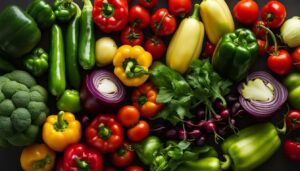Are you looking for a way to preserve your favorite salsa recipe for longer enjoyment? Canning homemade salsa is a fantastic solution that allows you to savor the flavors of summer all year round. However, it’s essential to follow safe canning practices to ensure that your salsa remains safe to eat and retains its delicious taste.
Contents
- 1 The Importance of Acid in Salsa Canning
- 2 Choosing the Right Tomatoes for Salsa
- 3 Selecting Peppers for Salsa
- 4 Adding Onions to Your Salsa Recipe
- 5 Spices and Herbs for Flavorful Salsa
- 6 Acidification and Safety Guidelines
- 7 The Importance of Research-Tested Recipes
- 8 Proper Storage and Consumption of Canned Salsa
- 9 Salsa Storage Tips
- 10 Conclusion
- 11 FAQ
- 11.1 Can you can any salsa recipe?
- 11.2 What is a homemade salsa recipe?
- 11.3 Why is acid important in salsa canning?
- 11.4 How do I choose the right tomatoes for salsa?
- 11.5 What peppers should I use in salsa?
- 11.6 Can I substitute different onions in my salsa recipe?
- 11.7 What spices and herbs should I use in salsa?
- 11.8 Why is acidification important in salsa canning?
- 11.9 Where can I find research-tested salsa canning recipes?
- 11.10 How should I store and consume canned salsa?
- 12 Source Links
Key Takeaways:
- Safe canning practices are crucial when preserving homemade salsa.
- Adding the right amount of acid is important to maintain the safety of canned salsa.
- Choosing the right tomatoes and peppers can impact the flavor and safety of your salsa.
- Using research-tested recipes and following storage guidelines are essential for maintaining the quality and safety of canned salsa.
- Proper storage and consumption practices ensure the best flavor and nutritive value of your homemade salsa.
The Importance of Acid in Salsa Canning
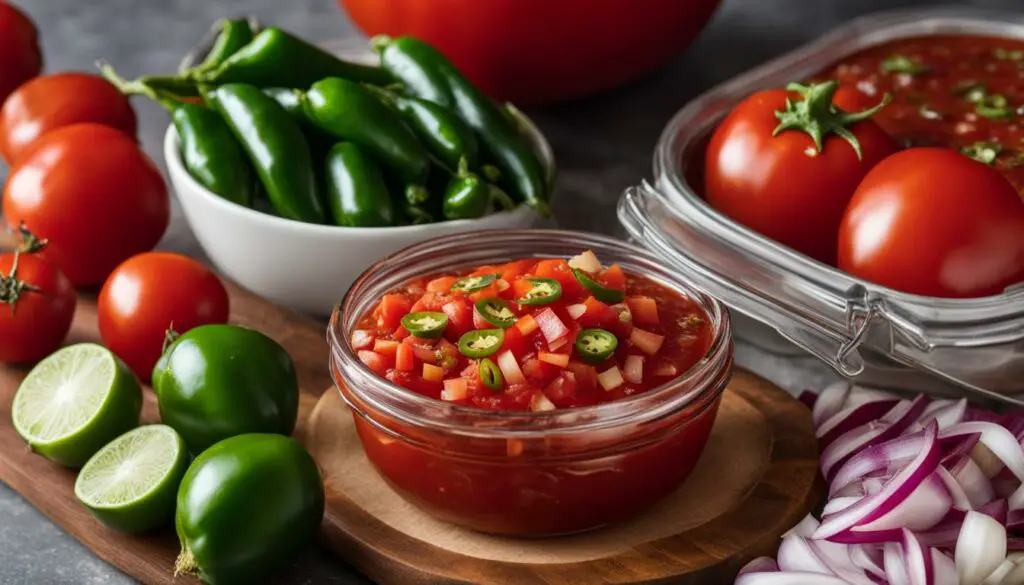
When canning salsa, it is crucial to include enough acid to ensure the safety of the final product. Tomatoes, which are a key ingredient in salsa, have varying levels of acidity. To lower the pH and prevent the growth of harmful bacteria like botulism, it is recommended to add commercially bottled lemon or lime juice or 5% acidity vinegar to the salsa recipe. This acidification step is essential for safe canning.
Adding acid to your salsa recipe is necessary because it increases the overall acidity, making it difficult for bacteria to survive and grow. The natural acidity of tomatoes alone may not be sufficient to prevent botulism, a serious foodborne illness. By incorporating an additional source of acid, you can create a safe environment for preserving your salsa.
The acid levels in commercially bottled lemon or lime juice and 5% acidity vinegar are reliable and consistent, making them ideal choices for acidifying your salsa. These ingredients are readily available and can be easily incorporated into your canning process.
When adding acid to your salsa recipe, it’s important to follow the recommended measurements and ratios to ensure proper acidification. This step is crucial for maintaining the safety and quality of your canned salsa.
To summarize, the acidification step is a vital part of salsa canning. By adding commercially bottled lemon or lime juice or 5% acidity vinegar, you can effectively lower the pH of your salsa, making it safe for long-term storage. So, don’t skip this important step and enjoy your homemade salsa all year round!
Choosing the Right Tomatoes for Salsa
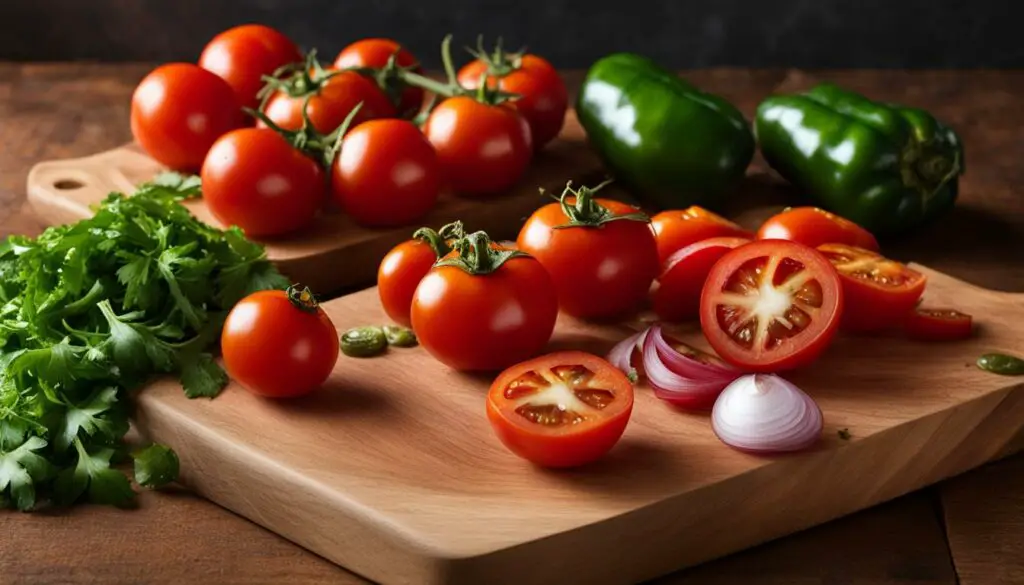
The type of tomatoes you use in your salsa can have a significant impact on its flavor and texture. When making a homemade salsa recipe, it’s important to select the right tomatoes to achieve the desired results.
Plum-style or paste tomatoes, such as Roma, are highly recommended for creating a thicker salsa consistency. These tomatoes have a lower water content, making them ideal for achieving a chunky and substantial texture.
On the other hand, if you prefer a thinner and more watery salsa, opt for slicing tomatoes. These tomatoes, like beefsteak or vine-ripened varieties, have higher water content, resulting in a lighter and more fluid consistency.
Regardless of the type you choose, it’s crucial to use fresh and firm tomatoes at their peak ripeness. This will ensure that you capture the maximum flavor and juiciness for your homemade salsa recipe. Avoid using overripe or damaged tomatoes, as they can affect the acidity level and compromise the safety of your final product.
The right choice of tomatoes will contribute to the overall taste and quality of your salsa. So, next time you’re preparing a homemade salsa recipe, be mindful of the tomatoes you select to achieve the perfect balance of flavors.
Selecting Peppers for Salsa
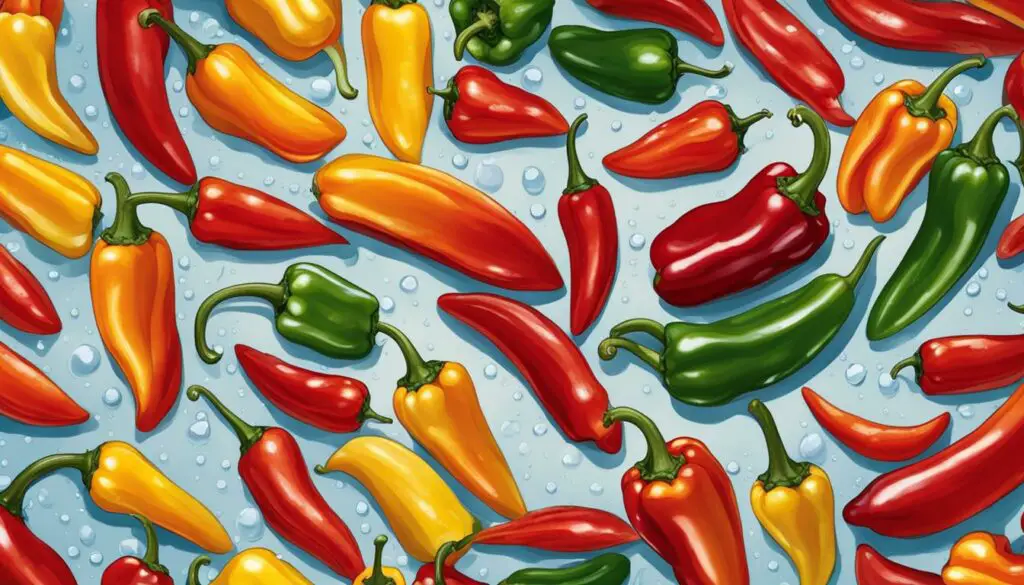
Peppers are another essential ingredient in salsa, adding both color and heat. When it comes to choosing peppers for your salsa recipe, you have a variety of options to consider. Here are some popular pepper choices:
- Jalapeno
- Serrano
- Cayenne
- Bell peppers
It’s important to note that while peppers contribute to the spiciness of salsa, you should avoid increasing the total amount of peppers in the recipe. Instead, you can substitute one type of pepper for another to adjust the heat level according to your preference.
When handling hot peppers, always wear gloves and avoid touching your face, as the oils from the peppers can cause irritation. If you prefer a milder flavor, you can use bell peppers as a substitute for long green chilies.
Adding Onions to Your Salsa Recipe
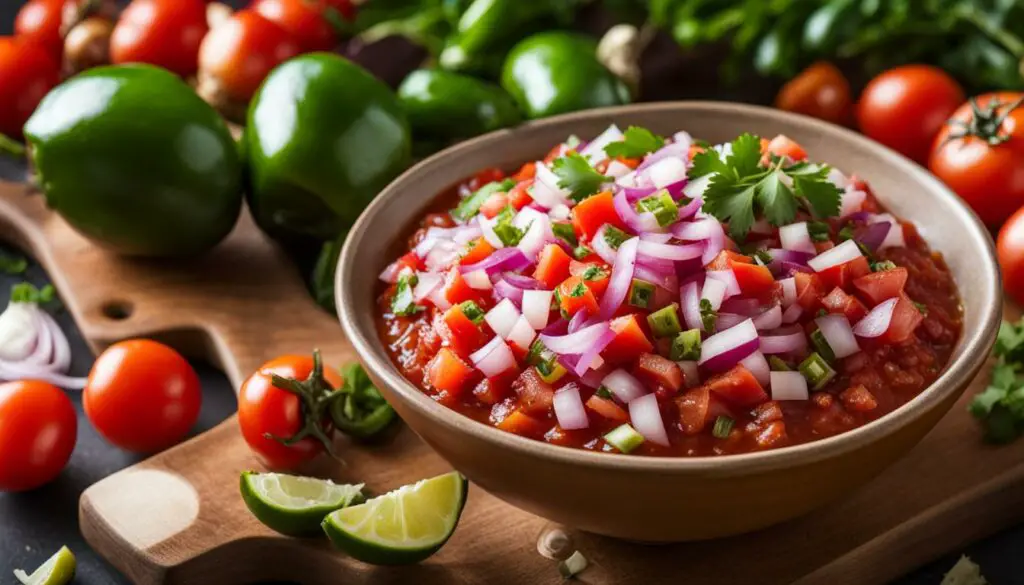
Onions play a vital role in enhancing the flavor of your homemade salsa. Whether you’re following a classic salsa recipe or looking to create an authentic salsa, onions are a key ingredient that adds depth and complexity to the taste.
You have the freedom to choose from various types of onions, such as red, yellow, white, or purple, based on your preference. Each type has its own unique flavor profile, allowing you to customize your salsa to suit your taste buds. From the mild sweetness of yellow onions to the subtle spiciness of red onions, there are endless possibilities to explore.
When adding onions to your salsa, it’s important to follow a few preparatory steps. Start by peeling the onion and removing the outer skin. Next, wash the onion thoroughly to ensure it’s free from any dirt or debris. Once cleaned, core the onion by removing the root and stem ends. Finally, dice the onion to the desired size, whether you prefer finely chopped or chunkier pieces.
Onions can also be substituted for one another in a salsa recipe. For example, if you prefer a milder flavor, you can opt for yellow onions instead of red onions. Experiment with different onion varieties to find the perfect balance of flavors for your salsa.
To give you some inspiration, here’s a simple recipe for classic salsa featuring onions:
Classic Salsa Recipe:
- 4 medium tomatoes, diced
- 1 small onion, finely chopped
- 1 jalapeno pepper, seeded and minced
- 1/4 cup fresh cilantro, chopped
- 1 tablespoon lime juice
- 1/2 teaspoon salt
- 1/4 teaspoon ground cumin
Mix all the ingredients in a bowl and let the salsa refrigerate for at least 1 hour for the flavors to meld together. Serve with tortilla chips or as a topping for your favorite dishes.
Incorporating onions into your salsa recipe adds a wonderful aromatic quality and enhances the overall taste. So don’t hesitate to experiment with different onion varieties and sizes to create a salsa that suits your palate perfectly.
Spices and Herbs for Flavorful Salsa
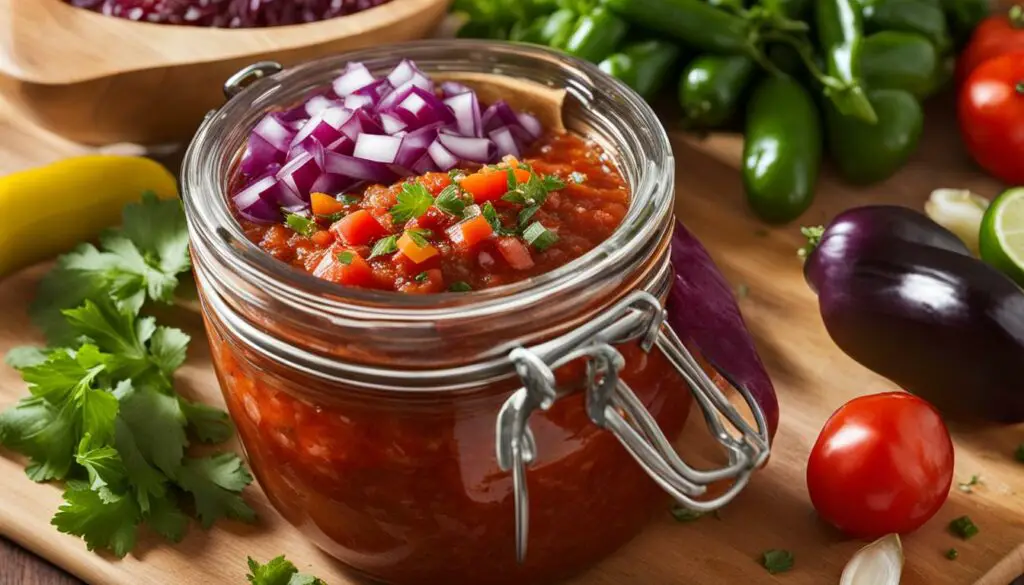
In addition to tomatoes, peppers, and onions, spices and herbs are essential ingredients that contribute to the flavorful profile of salsa. By incorporating the right blend of seasonings, you can customize the taste of your salsa according to your preferences. Whether you prefer a mild and tangy salsa or a spicy and vibrant one, the choice of spices and herbs will make all the difference.
When it comes to spicing up your salsa, feel free to adjust the amount of dry spices to suit your palate. This allows you to create a salsa that is perfectly seasoned to your liking while still adhering to the safety guidelines for canning. Remember, the safety of the product should never be compromised, but the intensity of flavor can be easily customized.
One herb that adds a burst of freshness to salsa is cilantro. With its citrusy undertones, it pairs perfectly with the other ingredients and elevates the overall taste. For the best flavor impact, consider adding fresh cilantro just before serving your salsa. Hot processing temperatures may dampen its flavor, so adding it at the end ensures its vibrant taste shines through.
Below is a list of common spices and herbs used in salsa:
| Spice/Herb | Flavor Profile | Pairing Suggestions |
|---|---|---|
| Cumin | Earthly, nutty, and warm | Tomatoes, peppers, onions |
| Paprika | Smoky, sweet, and mild | Tomatoes, onions, cilantro |
| Garlic powder | Savory and pungent | All ingredients |
| Oregano | Herbaceous and slightly bitter | Tomatoes, onions, cilantro |
| Black pepper | Pungent and slightly spicy | All ingredients |
| Chili powder | Hot, smoky, and flavorful | Peppers, onions, tomatoes |
Note: The table is just a starting point, and you can experiment with different spices and herbs to create your unique salsa recipe.
Lastly, it’s crucial to use spices and herbs that are safe for canning. Some herbs, like thyme and rosemary, can be safely used in salsa, while others, such as basil and parsley, are not recommended for canning due to their low acidity. Always consult reputable sources such as the National Center for Home Food Preservation for guidance on safe canning practices.
“The right combination of spices and herbs can transform a simple salsa into a burst of tantalizing flavors. Don’t be afraid to experiment and create your own signature salsa recipe!”
In the next section, we will delve into the acidification and safety guidelines that are crucial to follow when canning salsa.
Acidification and Safety Guidelines
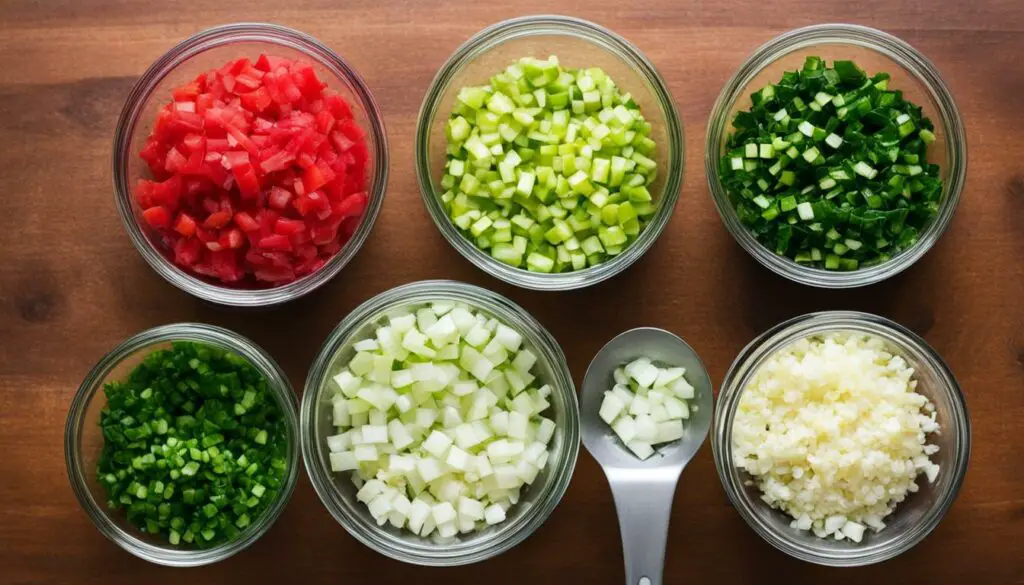
When it comes to salsa canning, acidification is a crucial step to ensure the safety of your homemade salsa. By following research-tested recipes and adhering to specific guidelines, you can prevent the growth of harmful bacteria and enjoy your delicious canned salsa with peace of mind.
One important rule to remember is to never reduce the amount of acid or tomatoes indicated in the recipe. These requirements are carefully calculated to maintain the proper pH level and prevent the risk of bacterial contamination.
When measuring your ingredients for salsa canning, it’s important to use the appropriate tools. Dry measuring cups should be used for tomatoes, onions, and peppers, while liquid measuring cups are suitable for bottled lemon or lime juice.
Pro Tip: To ensure accurate measurements, level off the ingredients in the cups using a straight edge, such as the back of a knife.
In addition, it’s crucial to avoid adding any thickeners like cornstarch or flour before canning. These ingredients can interfere with the safety of the product and impact the consistency of the salsa.
To summarize the acidification and safety guidelines for salsa canning:
- Follow research-tested recipes without reducing the amount of acid or tomatoes.
- Use dry measuring cups for tomatoes, onions, and peppers, and liquid measuring cups for bottled lemon or lime juice.
- Avoid adding thickeners like cornstarch or flour before canning.
By following these simple yet essential guidelines, you can ensure that your homemade salsa is both delicious and safe to enjoy!
The Importance of Research-Tested Recipes
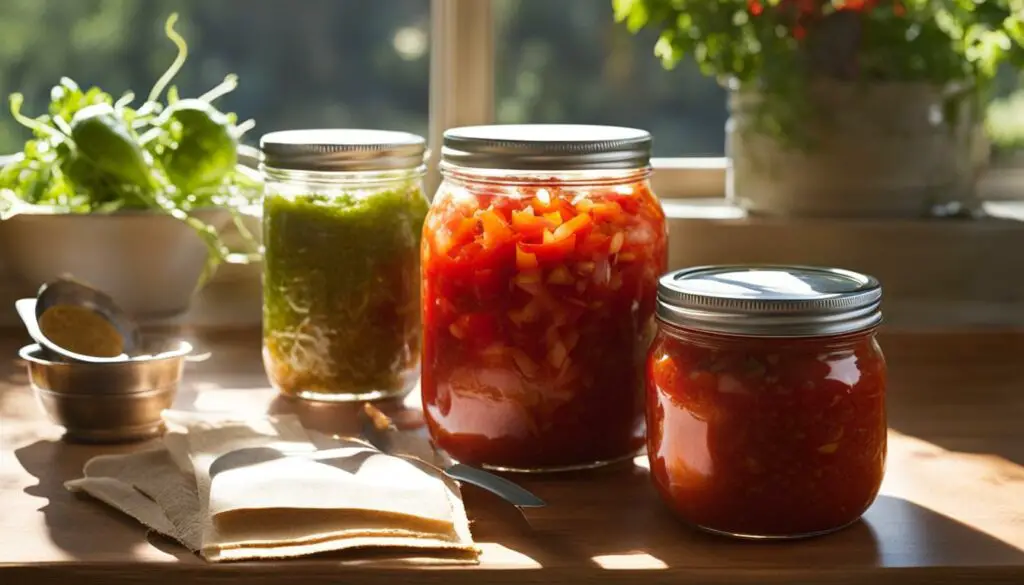
To ensure the safety and authenticity of your canned salsa, it’s crucial to use research-tested recipes developed and tested by reputable sources. Many online recipes may not adhere to USDA food safety standards, which can compromise the quality and safety of your homemade salsa. Instead, it’s important to seek out credible sources like government or university websites when looking for classic and authentic salsa canning recipes.
When it comes to canning salsa, following research-tested recipes is essential for several reasons:
- Food safety: Research-tested recipes have undergone rigorous testing to ensure that they meet the necessary safety requirements. By using these recipes, you can trust that your salsa will be properly processed to prevent the growth of harmful bacteria.
- Proper acidity: Research-tested recipes provide accurate measurements of acidifying ingredients, such as bottled lemon or lime juice, which are crucial for maintaining the proper pH level in canned salsa. This acidity helps prevent the growth of bacteria, ensuring the safety of your salsa.
- Flavor and texture: Research-tested recipes have been carefully developed to optimize the flavor and texture of salsa. These recipes have undergone thorough testing to ensure that the ingredient ratios, cooking times, and processing methods result in a delicious and well-preserved salsa.
Reputable Sources for Research-Tested Recipes
When searching for classic and authentic salsa canning recipes, it’s important to rely on trusted sources. Here are a few reputable sources that provide research-tested recipes:
“Using research-tested recipes developed by reputable sources, like the National Center for Home Food Preservation, ensures that your homemade salsa is both delicious and safe to enjoy.”
| Source | Website |
|---|---|
| National Center for Home Food Preservation | nchfp.uga.edu |
| University Extension Websites | Check your local university’s extension website for research-based salsa canning recipes. |
| USDA Complete Guide to Home Canning | nchfp.uga.edu/publications |
Using research-tested recipes developed by reputable sources, like the National Center for Home Food Preservation, ensures that your homemade salsa is both delicious and safe to enjoy. These recipes have been carefully tested to provide the perfect balance of flavors, textures, and acidity, guaranteeing a classic and authentic salsa experience.
Proper Storage and Consumption of Canned Salsa
After you’ve successfully canned your homemade salsa, it’s essential to store it correctly to maintain its quality and safety. Follow these guidelines to ensure your salsa stays fresh and delicious:
Storage
Store your home-canned salsa in a cool, dark place to preserve its flavors and nutritive value. A pantry or a cellar with a temperature of 50-70°F (10-21°C) is ideal for optimal storage conditions. Make sure the salsa jars are tightly sealed to prevent air and moisture from entering.
Keep the jars away from direct sunlight, as exposure to light can cause flavor changes and deterioration. Protecting your canned salsa from extreme temperatures is crucial, as it can lead to spoilage or affect the texture and taste.
Expiration Date
While homemade canned salsa can last for several years, it’s recommended to use it within one year for the best flavor. Over time, the flavors may mellow and the texture may slightly change, but it should still be safe to consume within this timeframe.
Opened Salsa
If you open a jar of salsa, it’s important to refrigerate it and consume it within a week. Once the jar is opened, contact with air can introduce bacteria and reduce its shelf life. Always check for signs of spoilage, such as mold growth, off smells, or unusual textures, before consuming the salsa.
Freezing Salsa
If you have leftover homemade salsa that hasn’t been canned, it can be frozen for longer-term storage. Freezing can extend the salsa’s shelf life, but keep in mind that the texture and flavor may undergo slight changes after thawing.
To freeze salsa, transfer it to a freezer-safe container, leaving some headspace for expansion. You can also use freezer bags, removing any excess air before sealing. Label the container with the date and contents to ensure proper rotation.
Salsa Storage Tips
| Storage Method | Duration | Recommended |
|---|---|---|
| Pantry | Up to 1 year | Yes |
| Refrigerator (opened jar) | Up to 1 week | Yes |
| Freezer (container) | Up to 6 months | Recommended |
Use these guidelines as a reference, but always trust your senses. If you notice any signs of spoilage, discard the salsa immediately to avoid the risk of foodborne illnesses.
Remember, proper storage and consumption play a vital role in enjoying your homemade salsa safely. So, savor the flavors of your tomato salsa recipe by storing it correctly and following these guidelines.
Conclusion
Canning your own salsa recipe can be a rewarding and delicious way to preserve the flavors of summer. By following safe canning practices and using research-tested recipes, you can ensure that your salsa is not only flavorful but also safe to eat. Whether you prefer a spicy or mild salsa, there are endless variations to explore.
Start by gathering your fresh ingredients – juicy tomatoes, vibrant peppers, aromatic onions, and flavorful herbs and spices. Follow the recommended guidelines for acidification, using bottled lemon or lime juice or vinegar to maintain the appropriate pH level.
Once you’ve canned your salsa, store it in a cool, dark place to maintain its quality and nutritive value. And remember, homemade salsa can be enjoyed all year round – a taste of summer in every bite!
FAQ
Can you can any salsa recipe?
Yes, you can can any salsa recipe, but it’s important to follow safe canning practices to ensure the salsa remains safe to eat.
What is a homemade salsa recipe?
A homemade salsa recipe is a recipe that allows you to make salsa from scratch using fresh ingredients.
Why is acid important in salsa canning?
Acid is important in salsa canning to ensure the safety of the final product by lowering the pH and preventing the growth of harmful bacteria.
How do I choose the right tomatoes for salsa?
Choose plum-style or paste tomatoes, such as Roma, for a thicker salsa, or slicing tomatoes for a thinner consistency. Use fresh, firm tomatoes at their peak ripeness for the best flavor.
What peppers should I use in salsa?
You can choose from a variety of peppers like jalapeno, serrano, cayenne, or bell peppers. Avoid increasing the total amount of peppers in the recipe, but you can substitute one type of pepper for another.
Can I substitute different onions in my salsa recipe?
Yes, you can use red, yellow, white, or purple onions interchangeably in your salsa. Just make sure to peel, wash, core, and dice the onions to your desired size before adding them to the recipe.
What spices and herbs should I use in salsa?
You can adjust the amount of dry spices to your personal taste without affecting the safety of the product. Fresh cilantro can be added just before serving to maximize its flavor.
Why is acidification important in salsa canning?
Acidification is a critical step in salsa canning to prevent the growth of harmful bacteria. It’s important to follow research-tested recipes and not reduce the amount of acid or tomatoes indicated in the recipe.
Where can I find research-tested salsa canning recipes?
You can find research-tested salsa canning recipes from reputable sources like the National Center for Home Food Preservation. It’s important to use these recipes to ensure the safety of your canned salsa.
How should I store and consume canned salsa?
Store home-canned salsa in a cool, dark place for optimal quality. Use the salsa within one year for the best flavor. Once a jar of opened salsa, refrigerate it and consume it within a week. Leftover salsa that hasn’t been canned can be frozen for longer-term storage.





